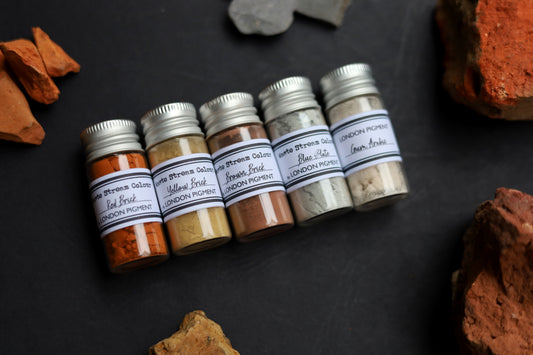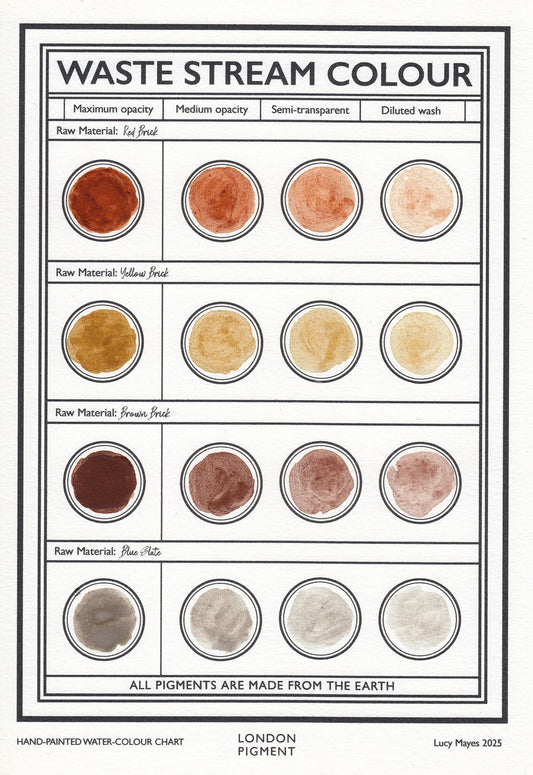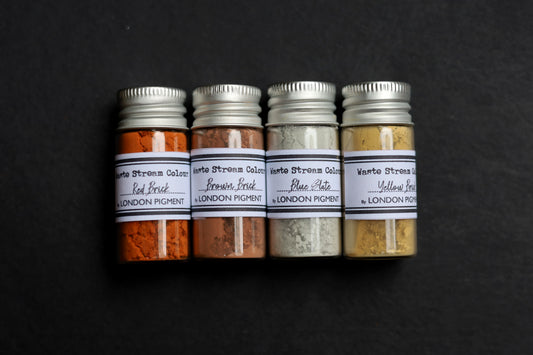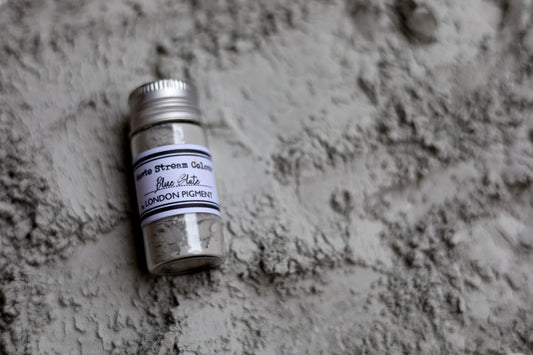Portfolio highlights
The following images and text represent the some of the highlights of Lucy Mayes' work with pigments. Her creative voice is manifest in various activities that perform her ideas visually: the giving of talks and workshops, the making of pigments from both esoteric raw materials and the recreation of historical recipes.
Lucy's purpose is to explore, research and teach mindful sustainable pigment practices, so that others can forge new ecologically aware behaviours and techniques relating to their own colour usage. This is done by the use of waste stream materials, biodegradable pigments and binders.
She works closely with clients to realise projects relating to sustainable colour making practices and the projects mentioned here are produced with these intentions.
Please share this online portfolio if interested in Lucy's work
A Selection of Talks & Workshops
In conversation with makeup artist and historian Lisa Eldridge at the Lisa Eldridge Store, Covent Garden, London, 2022.
 Lucy's display of London Pigments and raw pigment materials in front of Lisa's museum of makeup. Lucy Mayes 2022.
Lucy's display of London Pigments and raw pigment materials in front of Lisa's museum of makeup. Lucy Mayes 2022.
London Pigment Workshop, Tate Britain, Millbank, London, November 2020.

The set up for the workshop and talk at Tate Britain, in their learning space.
 Lucy showing participants of the workshop the different colours in a painting made from London Clay, verdigris and raw materials from waste stream sources.
Lucy showing participants of the workshop the different colours in a painting made from London Clay, verdigris and raw materials from waste stream sources.
L'Oréal Colour Congress 2022
London Pigments and the history of hair dye, workshop event for L'Oréal, London October 2022


The pigment table set up for Lucy's talk, The History of Hair Dye.
How To Paint The Mona Lisa, Channel 4 Documentary, 2022
Lucy was featured in the documentary to teach Adebanji how to make pigment and paint. She showed him how to mix pigment with linseed oil in order to make a traditional glaze medium, that Da Vinci would have used to paint thin, transparent layers for the 'sfumato' technique.

Russian Colour Theory & Paint Making with Lucy Mayes, Pushkin House, Bloomsbury, London. February 2020
 Installation shot of talk and exhibition, including paintings, pigment display and workshop set up.
Installation shot of talk and exhibition, including paintings, pigment display and workshop set up.
Previous talks & workshops
An introduction to pigments, online lecture, How to paint in watercolour course, V&A June 2022
Lucy Mayes & London Pigment, Artist talk via zoom for Beyond the Brush by New England Society of Botanical Artists (NESBA), May 2022
Colour From the Mines Presents: London Pigment Project with Lucy Mayes, Watercolour paint making with earth colours & talk about iron oxide pigments, Six Bells, Wales. May 2022
Q&A's with 6 notable pigment people, Artist talk via Zoom For nonprofit organisation Pigments Revealed International, March 2022
Grit, Artist talk via zoom, Colour & Poetry: A Symposium 2022, The Slade, UCL, March 2022
London Pigment, artist talk and paint making workshop, The Slade, UCL, February 2022
Making Colour Pigments From Plants, two day workshop for The V&A, London, March 2023
Lake Pigments from Kew Gardens, one day workshop at Kew Gardens, London, 1st May, 2023
Urban Pigment Foraging, An online course hosted by Plants and Colour. Two sessions, both two hours long, 11th & 25th April.
London Pigment Talk, The Slade, UCL for Colour & Poetry: A Symposium V, 21st/22nd March.
The Cornelissen & Son Pigment Archive, 2021-22
Between the years 2018- 2022 Lucy worked in the capacity of pigment consultant and historical art materials researcher at L.Cornelissen & Son. In this role she managed the organisation and conservation of the pigment archive of the store. The archive included objects such as 19th century pigment jars and related accoutrement. This collection of rare, historical objects was built up over the 168 years of Cornelissen's history.

Constable Green for Neptune Furnishing Stores, 2022
For this project a unique shade of green was created from historical pigments. Neptune commissioned Lucy to create a special colour, a pigment mix, based on historical recipes for their Autumn/Winter palette. This colour was created from verdigris, weld and carbon black that was derived from calcined London Plane tree. The eventual shade was a deep British racing green with a hint of black added. 
Colour swatches of the various shades of Verdigris used for the project.

Other pigment projects:
Bespoke exterior grade aluminium paint for Hannah Barry Gallery/Bold Tendencies for Richard Wentworth's site specific work Agora. (2023)
Bespoke pigments and ink palette made from Gleaned waste stream vegetable dyes for Natalie Joelle phD candidate. Working title: Gleaning Lean Culture: On Gleanologics' (2023)
A selection of artworks depicting Lucy's hand-made pigments
The Amber Room at The Round House, London, December, 2022

A selection of hand-made pigments, inks pigment and colour chart for The Amber room. The hourglass vessels were hand blown to Lucy's designs to display her pigments.

Hand-made pigments in 20ml glass bottles with wax seal, shown at The Amber Room.

Hand-made pigments in 40ml glass bottles, shown at The Amber Room. Images curtesy of Rosie Reed & The Amber Room 2022.
Paintings
The following watercolour paintings are made from handmade materials. The pigments are sourced from waste stream materials: construction waste (mineral) and plants (botanical lakes). The binder in the watercolour is created from cherry gum and water that was collected from East London.
The paintings take their form from historical colour charts, colour theory diagrams and artworks that deal chiefly with form and colour. By utilising these structures, Lucy recreates past works using pigments sourced from specific locations. She usurps the original purpose of the forms and the use of certain pigments and in their place uses her own. Many colour diagrams used pigments containing heavy metals such as cadmium and cobalt pigments which she switches for pigments crated from contemporary urban waste streams.

'After George Field', hand-made pigments and cherry gum on archival HP watercolour board, oak frame, 2022. Exhibited at The Shade, UCL as part of 'Colour/Pigment/Poetry' 2022.

Detail of 'After George Field', 2022.
 After Frank Stella, Brick dust, copper corrosion and carbon black on archival watercolour board, 2020
After Frank Stella, Brick dust, copper corrosion and carbon black on archival watercolour board, 2020

A walk along the Thames 2020, Materials: clockwise from top centre- Mudlark verdigris, Georgian yellow brick, London red brick, carbon black, brown brick, London iron oxide, London clay, charcoal, medieval clay tile, copper carbonate, brown-violet brick, victorian clay pipe, gum Arabic on archival watercolour paper, 2021.

Four Roundels, carbon black created from charred wood from London and Berlin, gum Arabic on archival watercolour paper, 2020.

Infinity Front Lawn, copper corrosion and Georgian yellow brick on archival watercolour board, 2020





Waste Stream Colour Products
-
Waste Stream Watercolour Complete Set
Regular price From £70.00 GBPRegular priceUnit price per -
Waste Stream Colour Chart
Regular price £15.00 GBPRegular priceUnit price per -
Waste Stream Colour Full Set
Regular price From £60.00 GBPRegular priceUnit price per -
Blue Slate Pigment
Regular price £15.00 GBPRegular priceUnit price per



